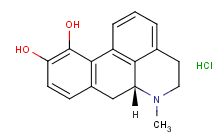-
Name
4H-Dibenzo[de,g]quinoline-10,11-diol,5,6,6a,7-tetrahydro-6-methyl-, hydrochloride (1:1), (6aR)-
- EINECS 206-243-0
- CAS No. 314-19-2
- Article Data4
- CAS DataBase
- Density g/cm3
- Solubility
- Melting Point >250℃
- Formula C17H17 N O2 . Cl H
- Boiling Point 473.4°Cat760mmHg
- Molecular Weight 303.788
- Flash Point 268.8°C
- Transport Information
- Appearance
- Safety Poison by intravenous and intraperitoneal routes. Mutation data reported. See also APORMORPHINE. When heated to decomposition it emits very toxic fumes of NOx and HCl.
- Risk Codes
-
Molecular Structure
- Hazard Symbols
- Synonyms 4H-Dibenzo[de,g]quinoline-10,11-diol,5,6,6a,7-tetrahydro-6-methyl-, hydrochloride, (6aR)- (9CI);4H-Dibenzo[de,g]quinoline-10,11-diol, 5,6,6a,7-tetrahydro-6-methyl-,hydrochloride, (R)-;6ab-Aporphine-10,11-diol, hydrochloride (8CI);(-)-Apomorphine hydrochloride;Apomorphine hydrochloride;Apomorphinium chloride;NSC 11442;R-(-)-Apomorphinehydrochloride;Uprima;
- PSA 43.70000
- LogP 3.58980
Apormorphine chloride Chemical Properties

Molecular Weight: 303.78332 g/mol
Molecular Formula: C17H18ClNO2
Flash Point: 253.6 °C
Boiling Point: 495.8 °C at 760 mmHg
Vapour Pressure: 1.87E-10 mmHg at 25 °C
Enthalpy of Vaporization: 79.24 kJ/mol
EINECS: 206-243-0
log P (octanol-water): 0.240
Water Solubility: 2.00E+04 mg/L at 25 °C
Henry's Law Constant: 3.66E-23 atm-m3/mole at 25 °C
Atmospheric OH Rate Constant: 9.54E-11 cm3/molecule-sec at 25 °C
H-Bond Donor: 3
H-Bond Acceptor: 3
Tautomer Count: 18
Exact Mass: 303.102607
MonoIsotopic Mass: 303.102607
Topological Polar Surface Area: 43.7
Heavy Atom Count: 21
Complexity: 374
Defined Atom StereoCenter Count: 1
Canonical SMILES: CN1CCC2=CC=CC3=C2C1CC4=C3C(=C(C=C4)O)O.Cl
Isomeric SMILES: CN1CCC2=CC=CC3=C2[C@H]1CC4=C3C(=C(C=C4)O)O.Cl
InChI: InChI=1S/C17H17NO2.ClH/c1-18-8-7-10-3-2-4-12-15(10)13(18)9-11-5-6-14(19)17(20)16(11)12;/h2-6,13,19-20H,7-9H2,1H3;1H/t13-;/m1./s1
InChIKey: SKYZYDSNJIOXRL-BTQNPOSSSA-N
Apormorphine chloride Toxicity Data With Reference
| 1. | mmo-sat 20 µg/plate | MUREAV Mutation Research. 137 (1984),17. | ||
| 2. | ipr-mus LD50:145 µg/kg | JMCMAR Journal of Medicinal Chemistry. 18 (1975),1194. | ||
| 3. | ivn-mus LD50:38 mg/kg | TXAPA9 Toxicology and Applied Pharmacology. 6 (1964),334. |
Apormorphine chloride Consensus Reports
Reported in EPA TSCA Inventory.
Apormorphine chloride Safety Profile
Poison by intravenous and intraperitoneal routes. Mutation data reported. See also APORMORPHINE. When heated to decomposition it emits very toxic fumes of NOx and HCl.
RIDADR: 3249
HazardClass: 6.1(b)
PackingGroup: III
Apormorphine chloride Specification
Apormorphine chloride (CAS NO.314-19-2) is also called (-)-Apomorphiniumhydrochloride ; (r)-id ; (theta)-id ; 11-diol,6-methyl-6a-beta-Noraporphine-1hydrochloride ; 6a-beta-Aporphine-10,11-diol,hydrochloride ; Apomorphinechloride . Apormorphine chloride (CAS NO.314-19-2) is high toxic. It is flammable. It will produce toxic fumes when buring. So the storage environment should be ventilate, low-temperature and dry. Keep Apormorphine chloride (CAS NO.314-19-2) separate from raw materials of food.
Related Products
- APORMORPHINE
- Apormorphine chloride
- 3141-93-3
- 31419-81-5
- 314244-45-6
- 314245-30-2
- 314260-78-1
- 314263-42-8
- 314267-78-2
- 314268-40-1
- 3142-72-1
- 314272-29-2
Hot Products
About|Contact|Cas|Product Name|Molecular|Country|Encyclopedia
Message|New Cas|MSDS|Service|Advertisement|CAS DataBase|Article Data|Manufacturers | Chemical Catalog
©2008 LookChem.com,License: ICP
NO.:Zhejiang16009103
complaints:service@lookchem.com Desktop View